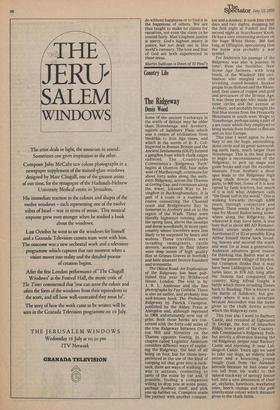The Ridgeway
Denis Wood
Some of the ancient trackways in the south of Britain may be older than Stonehenge and Avebury, regions of Salisbury Plain which was a centre of civilisation from Neolithic to Iron Age times, and which in the words of R. E. Collingwood in Roman Britain and the Ancient Settlements (OUP) formed a ganglion from which chalk ridges radiated. The Countryside Commission's `Ridgeway Path' begins at Overton Hill, four miles west of Marlborough, continues for about forty miles along the authentic Ridgeway, across the Thames at Goring Gap, and continues along the, lower, Icknield Way to Invinghoe in Buckinghamshire. It is part of a route or a number of routes connecting the Channel coast and Bridgewater Bay in Somerset to Avebury and on to the region of the Wasb. These were literally highways running above the spring lines, above the swamps and dense woodlands, in more open country where travellers were less likely to be surprised by bears and wolves. These travellers were invading immigrants, cattle drovers, workers in flint (there were deep mines of high quality flint at Grimes Graves in Norfolk) and later itinerant bronze founders and ironsmiths.
The Oldest Road: An Exploration of the Ridgeway has been published this year by Wildwood House, London. The text is by J. R. L. Anderson and the fine photographs by Fay Godwin. There is also an earlier, and probably less well-known book The Prehistoric Ridgeway by Patrick Crampton, published by the Abbey Press at Abingdon and, although reprinted in 1969, unfortunately now out of print. Both these books are concerned with the forty-odd miles of the true Ridgeway between Overton Hill and Streatley on the Thames opposite Goring. In the chapter called 'Logistics' Anderson considers different ways of exploring the Ridgeway, the best of all being on foot, but for those inexperienced in the use of the kind of camping kit that goes into a rucksack, there are ways of walking the way in sections, connecting to parts of the route by car and, if possible, finding a companion willing to drop you at some point, perhaps Avebury itself, and pick you up further on. Crampton made the journey with another compan
ion and a donkey. It took him three days and two nights, stopping for the first night at Foxhill and the second night at Scutchamer Knob. He has a very interesting section on the huge White Horse, 360 feet long, at Uffington, speculating that the horse was probably a war symbol.
For Anderson his passage of the Ridgeway was also 'a journey in time', from the Neolithic, New Stone Age farmers, with long heads, of the Windmill Hill civilisation who mingled with the invading round-headed Beaker people from Holland and the Rhineland, first users.of copper and gold and precursors of the Bronze Age. It was these people who made the inner circles and the avenue at Avebury, and probably brought the first blue stones from the Presscelly Mountains in south-west Wakes to Stonehenge, perhaps using a part of a sea route which they employed to bring metals from Ireland to Britain and on into Europe.
This year I went again to Avebury to see the huge, astonishing, stone circle and its great surrounding earth bank, much larger than Stonehenge. This is the best place to begin a reconnaissance of the Ridgeway, to pick up maps and guide books and visit the excellent museum. From Avebury a short spur leads to the Ridgeway high along chalk downs reaching, in parts, to 900 feet. Some of it is now rutted by farm tractors, but much of it is still what Anderson calls -the finest turf in the world." One is walking forwards through 4,000 years, through conjecture and legend. There seems to be a good case for Mount Badon being somewhere along the Ridgeway, but wherever it may have been, it was here that in about 493 AD RomanoBritish armies under Ambrosius Aurelianus (I or II) or possibly King Arthur himself threw back invading Saxons and secured the south and west for at least a generation. Anderson advances good reason for thinking that Badon was at or near the present village of Baydon, but Crampton thinks that it may have been Liddington Castle. Centuries later, in 870 AD, long after the Saxons had conquered the country, King Alfred fought a battle which threw invading Danes back to Reading. This is known as the Battle of Ashdown, but precisely where it was is uncertain because Aescesdun was the name given to the chalk downs across which the Ridgeway runs.
This year also I went to Barbury Castle, and revisited at Ogbourne St George, the foot of Smeathes Ridge, now a part of the Countryside Commission's Ridgeway Path, but strictly a diversion leaving the old Ridgeway proper near Barbury Castle and rejoining it near Liddington Castle. Years ago we used to take our dogs, an elderly Irish setter and a bouncing, young beagle (cast from the Airedale kennels because he had come up too tall from his walk) to this upland trackway of springy fescue turf, into a new dimension of clear air, skylarks, hawthorn, wayfaring trees, beech clumps and the pale amethystine colour which distance gives to the chalk fields.


































 Previous page
Previous page